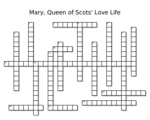
How much do you know about the men linked to Mary, Queen of Scots?
Test your knowledge of this Scottish queen’s love life with this fun crossword.
Simply click on the link or image below to open and print out…
[Read More...]
How much do you know about the men linked to Mary, Queen of Scots?
Test your knowledge of this Scottish queen’s love life with this fun crossword.
Simply click on the link or image below to open and print out…
[Read More...]
On this day in history, 29th April 1617, Sir Dru Drury died at the age of around 85 at his home, Riddlesworth Hall in Norfolk.
Drury may have died in the Stuart period, but he was a prominent Elizabethan. And he’s a man that went from being a prisoner to being Lieutenant of the Tower of London! Find out more about him…
[Read More...]
On this day in Tudor history, 24th April 1558, fifteen-year-old Mary, Queen of Scots, got married for the first time. The groom was fourteen-year-old Francis, the Dauphin of France.
Find out more about the bride and groom, their wedding and what happened to them…
[Read More...]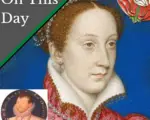
On this day in Tudor history, 19th April 1601, in Elizabeth I’s reign, bookseller James Duckett was hanged at Tyburn. Being a bookseller in Tudor times could be a risky business, particularly if you had the wrong kind of books on your premises!
[Read More...]
On this day in Tudor history, 9th March 1589, Lady Frances Radcliffe, Countess of Sussex, and wife of Sir Thomas Radcliffe, Lord Fitzwalter and 3rd Earl of Sussex, died at her home in Bermondsey.
Frances is known for being the benefactor of Cambridge University’s Sidney Sussex College, but there is much more to her than that. Her enemies even turned her husband and Queen Elizabeth I against her at one point!
Find out all about Frances Radcliffe (née Sidney) in this talk…
[Read More...]
Well, ok, perhaps love at second or third sight!
On this day in Tudor history, Saturday 17th February 1565, Mary, Queen of Scots, met and fell in love with Henry Stuart, Lord Darnley, at Wemyss Castle in Scotland. Just over 7 months later, the couple got married.
Find out more about the background of this meeting between Mary, Queen of Scots and Lord Darnley, Mary’s thoughts on Darnley, and what happened next, in this talk…
[Read More...]
On this day in Tudor history, 8th February 1601, Robert Devereux, 2nd Earl of Essex and Queen Elizabeth I’s former favourite, did a rather foolish thing and raised a rebellion against the queen and her council.
Spoilers: It didn’t go well and he ended up being executed as a traitor.
Find out exactly what happened in this talk…
[Read More...]
On this day in Tudor history, 3rd February 1537, in the reign of King Henry VIII, Thomas Fitzgerald, 10th Earl of Kildare (known as Silken Thomas), his five uncles and Sir John Burnell, were executed as traitors at Tyburn in London.
What led these men to these awful ends and why was Thomas known as “Silken Thomas”.
Find out more in this talk…
[Read More...]
On this day in Tudor history, 1st February 1587, Queen Elizabeth I called her secretary, William Davison, to her and asked him to bring her the death warrant of Mary, Queen of Scots. She then signed it. However, she didn’t want it to be sent to Fotheringhay, where Mary was held, until she said so. But it was sent.
Elizabeth wanted someone else to take responsibility for Mary’s death, she even wanted her gaoler to assassinate her!
Find out all about this, and how Mary DID end up being executed in February 1587, in this talk…
[Read More...]
On this day in Tudor history, 16th January 1572, Thomas Howard, 4th Duke of Norfolk, eldest son of the late Henry Howard, Earl of Surrey, was tried and found guilty of treason at Westminster Hall.
Norfolk had promised Queen Elizabeth I that he would not get involved with Mary, Queen of Scots, ever again, but it was a promise that he just couldn’t keep. Once again, he had become involved in a plot against Elizabeth I and in support of Mary, Queen of Scots. He wouldn’t escape punishment this time.
Find out exactly what happened in this talk…
[Read More...]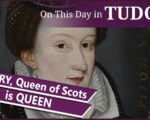
On this day in Tudor history, 14th December 1542, six-day-old Mary, daughter of King James V and his second wife, Marie de Guise, became Queen of Scotland – Mary, Queen of Scots.
King James V, who had ruled since 1513, was just 30 at his death.
Find out what happened to James V, and how Mary became queen at such a young age, in this talk…
[Read More...]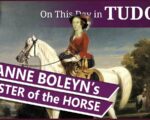
On this day in Tudor history, 8th December 1538, courtier and Master of the Horse to Queens Anne Boleyn and Jane Seymour, Sir William Coffin, died at Standon in Hertfordshire.
It is thought that he died of the plague because his wife Margaret wrote to Thomas Cromwell saying that Coffin had “died of the great sickness, full of God’s marks all over his body”.
Who was Sir William Coffin and what did the Master of the Horse do?
Find out in this talk…
[Read More...]
On this day in Tudor history, 2nd December 1586, following a joint petition from the Houses of Lords and Commons, Elizabeth I finally agreed to a public proclamation of sentence against Mary, Queen of Scots: death.
Mary had been found guilty of high treason back in October 1586, but Elizabeth had not wanted to contemplate regicide. However, Parliament believed that if Mary, Queen of Scots, was not executed, that she’d continue to plot against Elizabeth and would utterly “ruinate and overthrow the happy State and Common Weal of this most Noble Realm”. She was too much of a danger and needed dealing with once and for all.
Find out what Parliament said and what happened next in this talk…
[Read More...]
On this day in Tudor history, 28th November 1565, member of Parliament and political agent Francis Yaxley set sail for Scotland from Antwerp.
Sadly, Yaxley’s ship was wrecked in a storm and he never reached Scotland, and neither did the gold he was carrying to Mary, Queen of Scots.
But why was he carrying gold and who was it from? What happened to the gold?
Find out all about Yaxley, how he came to be traveling from Antwerp to Scotland, and what happened to him and the gold, in this talk…
[Read More...]
On this day in Tudor history, 14th October 1565, diplomat and poet, Sir Thomas Chaloner the Elder, died at his home in Clerkenwell, London. He was just forty-four years old. He’d served four Tudor monarchs as a diplomat, but he also wrote English and Latin works.
Find out more about Thomas Chaloner, his life, his career, and how his teeth saved him from death…
[Read More...]
On this day in Tudor history, 26th September 1588, Sir Amias (Amyas) Paulet, administrator, diplomat, Governor of Jersey and gaoler of Mary, Queen of Scots died. He was buried in St Martin-in-the-Fields, Westminster.
Sir Amias Paulet acted as gaoler to Mary, Queen of Scots, and it was while he was doing this that Elizabeth wanted him to abide by the Bond of Association and assassinate Mary, Queen of Scots, so that she didn’t have to sign her death warrant.
What was the Bond of Association and what did Paulet do?
Find out…
[Read More...]
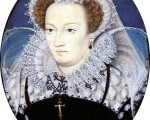

On this day in Tudor history, 19th August 1551, Princess Mary, the future Mary I, wrote to her half-brother King Edward VI regarding orders that he had sent, orders that she was not going to obey.
As historian Henry Ellis noted, this letter is evidence of Mary’s talent at writing and her intellect, and it also shows just how stubborn she could be. But then Edward was stubborn too! He wasn’t going to let his sister defy him but she wasn’t going to obey him and compromise her faith – oh dear!
Find out more about the situation, and hear Mary’s words to Edward…
[Read More...]
I’m just putting the finishing touches to a course I’ve written for MedievalCourses.com on the fascinating 16th-century queen, Mary, Queen of Scots.
The course goes live on 1st September 2021, but you can pre-order it right now and save $25 with coupon code MQS2021 by going to…
[Read More...]
In going through our resources, we came across this wonderful recording of John Guy talking about Mary, Queen of Scots. This was recorded on the Executed Queens tour of 2012.
[Read More...]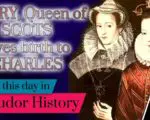
On this day in Tudor history, on 19th June 1566, in Scotland, Mary, Queen of Scots gave birth to a baby boy who would grow up to be King James VI of Scotland and King James I of England. He was baptised Charles James though.
Find out more…
[Read More...]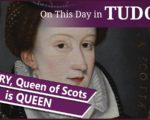
On this day in Tudor history, 14th December 1542, six-day-old Mary, daughter of King James V and his second wife, Marie de Guise, became Queen of Scotland – Mary, Queen of Scots.
King James V, who had ruled since 1513, was just 30 at his death.
Find out what happened to James V, and how Mary became queen at such a young age, in today’s talk.
[Read More...]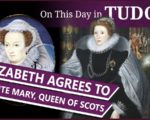
On this day in Tudor history, 2nd December 1586, following a joint petition from the Houses of Lords and Commons, Elizabeth I finally agreed to a public proclamation of sentence against Mary, Queen of Scots: death.
Mary had been found guilty of high treason back in October 1586, but Elizabeth had not wanted to contemplate regicide. However, Parliament believed that if Mary, Queen of Scots, was not executed, that she’d continue to plot against Elizabeth and would utterly “ruinate and overthrow the happy State and Common Weal of this most Noble Realm”. She was too much of a danger and needed dealing with once and for all.
Find out what Parliament said and what happened next in today’s talk.
[Read More...]
On this day in Tudor history, 28th November 1565, member of Parliament and political agent Francis Yaxley set sail for Scotland from Antwerp. Sadly, Yaxley’s ship was wrecked in a storm and he never reached Scotland, and neither did the gold he was carrying to Mary, Queen of Scots.
But why was he carrying gold and who was it from? What happened to the gold? Find out all about Yaxley, how he came to be travelling from Antwerp to Scotland, and what happened to him and the gold, in today’s talk.
[Read More...]
On this day in Tudor history, 26th September 1588, Sir Amias (Amyas) Paulet, administrator, diplomat, Governor of Jersey and gaoler of Mary, Queen of Scots died. He was buried in St Martin-in-the-Fields, Westminster.
Sir Amias Paulet acted as gaoler to Mary, Queen of Scots, and it was while he was doing this that Elizabeth wanted him to abide by the Bond of Association and assassinate Mary, Queen of Scots, so that she didn’t have to sign her death warrant.
What was the Bond of Association and what did Paulet do?
Find out in today’s talk…
[Read More...]
On this day in Tudor history, 9th September 1543, the 30th anniversary of the Battle of Flodden, Mary, Queen of Scots, was crowned queen at the Chapel Royal of Stirling Castle. Mary was just nine months old.
Find out more about how Mary came to the throne, her coronation ceremony, in which Mary howled, and how she was already promised in marriage to Henry VIII’s son, the future Edward VI, in today’s talk.
[Read More...]
On this day in Tudor history, 7th August 1548, five-year-old Mary, Queen of Scots set sail from Dumbarton in Scotland bound for France.
A marriage had been agreed between Mary and Francis, the Dauphin, so Mary was going to be brought up at the French court. Mary travelled with her maids of honour, the Four Marys, or the Queen’s Maries: Mary Fleming, Mary Beaton, Mary Seton and Mary Livingston.
Find out more in today’s talk.
[Read More...]
On this day in Tudor history, 23rd July 1543, or 24th according to some sources, Marie de Guise and her baby daughter, Mary, Queen of Scots, escaped from Linlithgow Palace, helped by Cardinal David Beaton, and taken to Stirling Castle.
Why? What was going on in Scotland at this time?
Find out all about Mary’s early months as Queen of Scots, and why Beaton helped her and her mother to move to Stirling, in today’s talk.
[Read More...]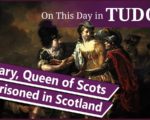
On this day in Tudor history, 17th June 1567, Mary, Queen of Scots, was imprisoned at Loch Leven Castle following her surrender at the Battle of Carberry Hill on 15th June.
Sadly, while she was imprisoned there, she miscarried twins and was forced to abdicate. She eventually escaped, but her freedom was only temporary.
Find out more about this time in Mary, Queen of Scots’ life in today’s talk.
[Read More...]